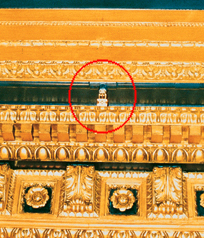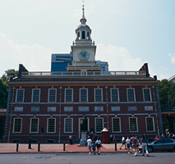Copper Protects Historic Buildings
Both Independence Hall and the Pennsylvania State Capitol are now protected for the first time by copper fire sprinkler systems. In addition to ensuring unimpeded water flow for more than 70 years, copper tubing can be installed with minimum disruption under sensitive, occupied conditions.
In a three-year project at Independence Hall in Philadelphia, 14,000 feet of copper tube plus copper fittings were installed in walls throughout the five-building complex, which was largely constructed in the 18th Century. Because copper tube has an external diameter significantly less than steel tube of the same internal diameter, using copper results in less wall damage and therefore less need for restoration after installation.
This is one of the main reasons why copper was the unanimous choice of those organizations involved in the project. They were: the National Park Service, which had jurisdiction for the project; Majek Fire Protection, Inc., Thorofare, N.J., the fire-protection contractor; Daniel J. Keating Co., Ardmore, Pennsylvania, the general contractor; and Vitetta Group, Philadelphia, the architect/engineers.



(Left) Painted sprinkler heads blend inconspicuously with the gold decoration in the all-copper sprinkler system installed recently in the Pennsylvania State Capitol. (Middle) Sprinker control valves feeding system in Independence Hall, Philadelphia (Right).
Disruption Minimized
Copper tube was chosen for the sprinkler system in the Capitol in Harrisburg by the state's Department of General Services for two main reasons: to minimize the disruption caused by working while the building was occupied; and as the best means of preserving the historic building's features, surfaces and finishes. As in Independence Hall, copper tube permitted artistic concealment plus the ability to locate sprinkler heads within existing architectural features with exacting precision.
In instances where total concealment was not possible, copper tube was matched to adjacent ornate finishes by careful painting-copper tube takes paint finishes exceptionally well. A bright brass finish on the sprinkler heads was selected because it closely resembles adjacent gold-leaf applique. Cleanliness during installation was another criterion reinforcing the choice of copper by the Capitol Preservation Committee, which closely scrutinized every aspect of the work.
Fire Protection Industries, Inc., Bensalem, Pennsylvania, was aided by the Copper Development Association in the installation of the sprinkler system. The design professionals for the project, Brinjac, Kambic & Associates, Harrisburg, also concurred in the specification of copper tube. The general contractor on the restoration project was CCI Construction Company, Mechanicsburg. Opened in 1906, the Capitol was designed to resemble the nation's capitol, which had been completed 35 years earlier. Known as a "palace of art," the 633-room building has 202 handsome mahogany and oak clocks.
In fire sprinkler systems, copper tube offers other advantages over competitive materials. For instance, because fittings are brazed using a nitrogen-purged atmosphere, the water in systems can flow through clean passageways. As a result, water quality over the long life of copper systems is expected to remain so high that there's little chance for stain damage from a discharge, whether accidental or in response to a fire. If steel pipe were used, a discharge is likely to cause unsightly stains from rusty water, especially in older systems. For more information on the advantages of copper tube, visit our Plumbing section.
Brinjac, Kambic: 717/233-4502
CCI Construction: 717/909-4224
Fire Protection Industries: 800/969-3775
Daniel J. Keating Co: 610/645-5300
Majek Fire Protection: 609/895-4800
Also in this Issue:
- Bronze Endures Beneath The Sea
- Copper Cable Enables High-Speed Communications
- Copper Enhances Manufactured Home
- Copper Protects Historic Buildings
- Copper-Wound Motors Help Lessen Air Pollution
